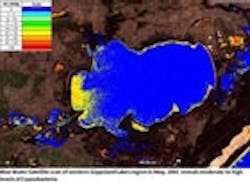Ohio Satellite Company Wins Contract to Seek Out Toxic Algae in Australia
Blue Water Satellite Inc. officials in Bowling Green, Ohio, are on the hunt for toxic algae and the nutrients that create the toxins in southeast Australia. The collaborative project, which includes officials from Blue Water Satellite, Environmental Protection Agency Victoria and Monash University in suburban Melbourne, Australia, will focus on the Gippsland Lakes region, a chain of brackish lakes about 140 miles east of Melbourne.
Satellite experts access raw data from USGS satellites Landsat 5 and 7, then process the data through the company’s patented and proprietary algorithms, revealing the locations and concentrations of Cyanobacteria, Chlorophyll-a, and phosphorus in water and surface soils. Researchers at Bowling Green State University developed the technology.
In recent years, toxic algae blooms have plagued lakes and rivers throughout Australia and New Zealand. The algae, alternately called Cyanobacteria and blue-green algae, contain a toxin that causes nerve damage in humans. It has also been linked to Parkinson’s, Lou Gehrig’s and Alzheimer’s diseases. Last year, a number of Ohio lakes and some Lake Erie beaches were closed after high levels of Cyanobacteria were detected.
Blue Water Satellite workers will also scan Australia’s Gippsland Lakes for phosphorus levels. Phosphorus comes from agricultural runoff and sewage treatment plants, and is the primary nutrient that causes the toxic algae to grow to dangerous proportions.
Source: Blue Water Satellite Inc.
